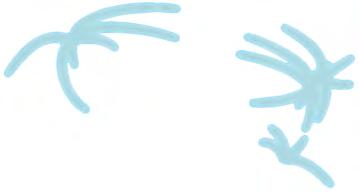
19 minute read
Mercy Ships – The Surgery Ship by Kapil Berry
Risk based Inspection
A better concept of maintenance of ships
Advertisement
Risk Based Inspection (RBI) is an Optimal maintenance business process used to examine equipment such as pressure vessels, heat exchangers and piping in industrial plants. It examines the Health, Safety and Environment (HSE) and business risk of ‘active’ and ‘potential’ Damage Mechanisms (DMs) to assess and rank failure probability and consequence. This ranking is used to optimize inspection intervals based on site-acceptable risk levels and operating limits, while mitigating risks as appropriate. RBI analysis can be qualitative, quantitative or semi-quantitative in nature.
Risk-Based Inspection (RBI) is an analysis methodology and process that, as opposed to condition-based inspection, requires qualitative or quantitative assessment of the probability of failure (PoF) and the consequence of failure (CoF) associated with each equipment item, piping circuits included, in a particular process unit. A properly-implemented RBI program categorizes individual pieces of equipment by their risks and prioritizes inspection efforts based on this categorization.
RBI is used to identify and understand risk, risk drivers, and where equipment is in its lifecycle. RBI can indicate whether inspection is needed; however this requires additional data that is extremely targeted to reduce the underlying uncertainties associated with the risks about the current and future predicted damage state of the equipment. RBI should not be used to recommend any inspection when it will not improve knowledge about the damage state. In those cases, where PoF is driving the risk, RBI should point to other mitigation options such as replacement, repair, or other actions that satisfy the risk criteria.
the uncertainties around the true damage state of the equipment and the dynamics leading to such. The resulting inspection plan may outline the type and scheduling of inspection for an asset.
Consistency and repeatability of analysis are critical to producing an effective RBI program, as RBI is based on relative risks. Caution should be used when mixing RBI platforms (e.g., using a qualitative method to perform the initial screening and quantitative methods to conduct the final analysis). Complementary methodologies must be calibrated against one another to ensure valid cut sets are achieved.
The essential idea was (and continues to be) designing an inspection program which manages the risk of equipment failures. Three major goals have been identified:
1. Define, quantify and rank the risk of process equipment failure to target the most important elements in a process plant 2. Give the ability to review safety, environmental, and businessinterruption risks in an integrated, cost-effective manner 3. Systematically reduce the likelihood and consequence of failure by allocating inspection resources to high risk equipment
There are two dimensions to a risk matrix. The combination of probability and severity will give any event a place on a risk matrix. See figure 1.
Severity
Extensive
Major
Medium
Minor
No Impact
Highly Unlikely Unlikely Possible Likely Very Likely
Above Figure 1
Not Acceptable
ALARP
Acceptable
Probability
Equipment / Component Risk Calculation in Detailed Analysis
Risk = Likelihood of Failure Consequence of Failure
MF GFF DF CoF
Abbreviations
DF - Damage Factor GFF - Generic Failure Frequency MF - Management Factor Age
Damage Type / Rate
Inspection E ectiveness Injury
Equipment Repair
Business Int.
Environ. E ects
Above Figure 2
Risk based Inspection Methodology
RBI emphasises the benefits of inspecting specific areas of the process plant. It is known that a large percentage of the total unit risk will be concentrated in a relatively small percent of the equipment’s. So, from all equipment items that are competing for attention, the idea is to review the inspection plan focusing on those components with the highest risk. As the process plant changes with on-going operations, inspection priorities and frequencies will be guided by the RBI process.
In 2016, RBI application boundary was extended to fixed equipment in refining, petrochemical, chemical process plants and oil and gas production facilities. This includes specific assets such as pressurized fixed equipment including pressure vessel, piping, tanks, pressure relief devices (PRDs), and heat exchanger tube bundles.
Classification societies like DNV-GL, Lloyds, ABS etc have developed their own SOFTWAREs for implementation of RBI commencing from Risk analysis.
The concept of inspection effectiveness is introduced as part of the risk management process. As damage accumulates during in-service operation, risk increases which then should trigger an inspection activity of enough effectiveness.
Methodology used by DNV-GL Risk: POF x COF
In mathematical terms, the risk for a scenario s is: R s = F s x C s, where, s - scenario number; Fs - failure frequency (per year) for scenario s; Cs - consquence (area in m2, PLL, or cost) for scenario s.
CoF can be expressed in terms of the environmental/safety consequence effects and the economic effects. PoF is the product of the Generic Failure Frequency (GFF), statistical frequency of failure for a given equipment item and the damage factor (DF).
Figure 3 illustrates the process of determining the next inspection date and the inspection effectiveness. A maximum acceptable risk level is set by the user. A future evaluation date is then selected by the user, it is typically the date of the 2nd turnaround, and the risk is calculated as a function of time.
If the risk at the future evaluation date exceeds the maximum acceptable level, an inspection is suggested. The intersection of the risk curve and the maximum acceptable line sets the next inspection date.
Inspection Management
Inspection includes all damage mechanisms and risk factors, predicts corrosion, plans inspections and manages anomaly and follow-up maintenance activities. In addition, schedules and work packages are also considered taking into account the operational impact.
The plan-do-check-act (PDCA) engineering cycle is most common system being used for inspection process. See Figure 4.
Inspections typically employ non-destructive testing (NDT).
Items with high probability and high consequence (i.e. high risk) are given a higher priority for inspection than items that are high probability but for which failure has low consequences. This strategy allows for a rational investment of inspection resources.
Objectives of RBI
RBI assists a company to select cost effective and appropriate maintenance and inspection tasks and techniques, to minimize efforts and cost, to shift from a reactive to a proactive maintenance regime, to produce an Auditable System, to give an agreed “operating window”, and to implement a Risk Management tool.
The purposes of RBI include:
1. To improve risk management results 2. To provide a holistic, interdependent approach for managing risks 3. To apply a strategy of doing what is needed for safeguarding integrity and improving reliability and availability of the asset by planning and executing those inspections that are needed 4. To reduce inspections and shutdowns and provide longer run length without compromising safety or reliability 5. To safeguard integrity 6. To reduce the risk of failures
7. To increase plant availability and reduce unplanned outages 8. To provide a flexible technique able to continuously improve and adopt to changing risks 9. To ensure inspection techniques and methods consider potential failure modes
Acceptable Risk Level Predicted Risk Increase
Time to next inspection
Fairly E ective
Highly E ective
Now
Last inspection date
1 Turnaround st
Time
2 nd Turnaround
Maximum inspection interval
Reference Standards
International engineering standards and recommended practices outline requirements, methodologies and the implementation of RBI.
• API 580 Risk-Based Inspection - Recommended Practice (Third edition, February 2016) • EEMUA 159 Chapter 17 RBI methodology for aboveground storage tanks • ASME PCC-3 Inspection Planning Using Risk-Based Methods • API 581 Risk Based Inspection Methodology - Recommended
Practice (Third edition, April 2016) • DNV-RP G101 Risk Based Inspection Of Offshore Topsides Static
Mechanical Equipment • API 571 Damage Mechanisms Affecting Fixed Equipment in the
Refining Industry
Hindrances to application of RBI on board vessels like Large Oil Tankers; Gas Carriers are availability of reliable and accurate DATA to carryout Risk Analysis. Ship board situation fluctuates with loading condition of the vessel and weather condition during the voyage. Accurate Data of these variables are difficult to achieve, causing uncertainty of RBI report.
Classification Societies need to explore the application of RBI for Ocean Going Vessels, specially Oil Tankers, Gas Tankers to enhance Safety, to Reduce Maintenance/Inspection costs and to Reduce financial loss arising out of sudden failure of a facility. ▄
Data with respect to Facility Location
Data with respect to Operation
Data with respect to Risks
Facility may be a cargo tank, pipeline, heat exchanger etc.
RBI
Data bank of the Facility Inspection
Schedule
Corrective Action / Follow-up
Action in case of non-complied action Inspection
Checklist
Do
Inspection as per schedule and checklist
Check
Verification of Inspection
compliance with schedule and checklist
Resource
Above Top Figure 3 ; Above Bottom Figure 4
My Passion for Photography
1
By Arvind Singh Roll Number 4637 Class of 1997
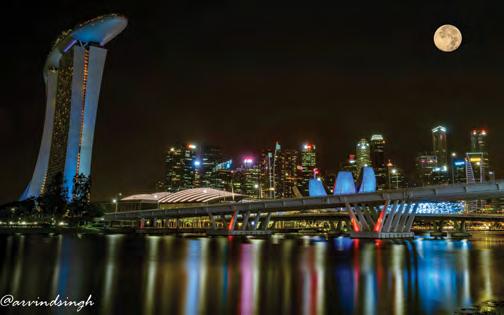
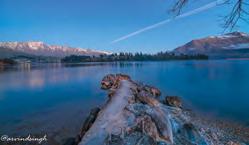
2 3
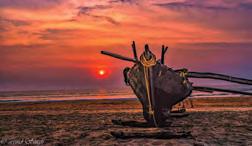
1 Marina Bay Waterfront Camera Sony alpha 7II / lens : Sony 16-35mm@35mm for Cityscape + Sigma 70-200 for moon / Composite image 2 Queenstown New Zealand Camera Sony alpha 7II / lens Samyang 14mm f2.8 manual / f-16/ISO 50/ 20 sec 3 GOA Camera Sony alpha 7II / Lens Sony 16-35mm@30mm/ f-22/ ISO 50/ 1 sec
Pangong Tso
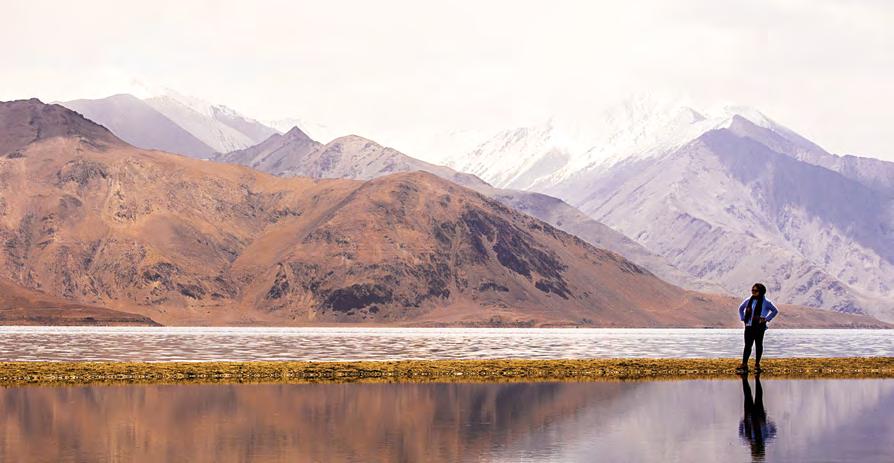
By Saurabh Ganguli Roll Number 4541 Class of 1997 and Shaonlee Ganguli
“My head hurts” said Bikki - my boy had turned six earlier this month. Sitting inside a camp few meters away from Pangong Tso, I felt a sense of persistent anxiety. I tried to recollect all that I had read and gathered before I came for this trip, looking for ways to alleviate his pain. The reason we had put away this trip for four years was staring back at me now. Perhaps this was too early, I felt deeply guilty. What happens if this only increases? How far do I have to travel if I need to reach a medical facility? Should I administer oxygen from a can? How many times? The little fellow was struggling to adjust to the lack of oxygen in the air. The sub-zero temperature outside and the howling winds only compounded the problems.
I rummaged through the medicine kit to give him all that was recommended. He fell asleep quickly. The drive from Leh had worn him down. My 10-year-old-son, Ahaan, was reading his book nearby, he didn’t look ill, but wasn’t energetic and sprightly either. I gave him some preventive medicines, already in total panic mode. Was it okay for one to sleep right after the medicines? I asked myself, sifting through my brains to recollect what I had read, and came up with nothing. Google had officially stopped working from Leh airport. There was absolutely no data services anywhere in Ladakh, no voice either. I did not know if I should let him sleep or wake him up, but I instinctively choose to let him rest and stepped out of the camp, partly because I needed to clear my head and party because the unseen, unruly breeze was taking shape of a persistent young adolescent, out drunk, one festive evening.
I walked towards the lake which looked like a massive blue jewel to me - the wind and the mist combined to create a most surreal play on the water. Waves crashed on the rocky beach, the multicolored mountain ranges on the other side seemed full of mystery and stories. No one knew what lies there…I told myself. I walked by a now deserted coastline, rocky but pristine and so deeply meditative that I was tempted to wander off despite the breathlessness and a restless little boy at the camp nearby.
A few photographers were wrapping up their gear, mine however was just getting started. The low light and the ‘golden hour’ are Saurabh’s favorite time for shoots. I saw him remove his jacket and gloves impatiently to point the camera at the distant horizon where I could not see anything. The light dimmed further and he started working faster. These were his ideal conditions - the cold fueled him, the vast emptiness surrounding us helped him think and compose, the failing light gave his work a magical silence that is both unique and refreshing. I sat afar observing him, obsessed with his craft and in a place far away, discovering new limits and building new stories.
The place induces a restful lull…by now I am a little less worried about acclimatization and headaches and food choices for dinner. I found it hard to look away from the lapping waves at my feet and looked at the distant. I told myself I will miss the dramatic expanse of multicolored mountain ranges, but by now I have made friends with that persistent young adolescent wind and his equally charming love – the tempestuous waves.


The morning after was bathed in golden sunlight – the sky was dotted with playful clouds and the bitter chill of the night swept away by the glorious sun. We spent hours by the lake, stacking pebbles and chucking them in the lake.
Ahaan and Bikki found a pair of cute horses to ride along the lake completely overwhelmed by the beauty all around them.
We avoided those “Three Idiots” inspired props that had made its way to the lakeside and walked by the coastline following soaring seagulls till we found some very gentle Yaks, by the lake, decorated in Ladakhi gear, waiting to ferry tourists around. The boys fell instantly in love with these gentle beasts. Bikki had forgotten his headache and they fussed around these mighty creatures like they were puppies in our backyard.
These unexpected bondings have a way of nudging itself into our hearts and staying there forever. From the look of it the boys were going to remember Chotu and Rancho, for a long time to come. My ten-year-old son, Ahaan had read some books on Ladakh before we came for the trip. While we were focused on preparing ourselves for medical exigencies, packing the right gear, he spent all his time researching about wildlife and birds of Ladakh.
On top of the list, was the majestic black necked crane. In India, this bird is found only in Ladakh around marshy wetlands, although there have been some sightings in Arunachal Pradesh. Sadly, only a handful of them remain now. Some say in Ladakh, the population is less than 50 around this time of the year, mainly because loss and degradation of habitat, feral dogs and the fact that they only have one egg or two has seriously affected the population. A sighting in Pangong Tso was most probable, Ahaan told us. He had stayed up, looking out of the window throughout the journey. He wanted us to hire a bird watching camp and get up at 4 am to try and track them by the lake. We couldn’t find a bird watching camp for hire and 4 am in the morning was dark, dangerous and so cold that we couldn’t bear to step out of the camp. As we drove towards Leh, without seeing one, he seemed entirely dejected. Perhaps in our next trip, we consoled, but chances are the bird will get even more rare then, he told us quietly as his nose touched the floor of the car. We couldn’t argue with that. ▄
What They Don’t Teach You in DMET!
By Vinay Gupta Roll number 3972 Class of 1993
Ibelong to the DMET (‘college’) batch of 1989-93. I would like to share my view point on various issues that loom largely on the education system in shipping.
At the time when we joined college and the time we spent there, we were all trained to be Marine Engineers. Our aim was to be a Chief Engineer onboard ships and most of us could not see the path beyond that. The college also had the syllabi prepared with the same philosophy - ‘fit for purpose’ and majority of the focus was on the subjects that we would be using as marine engineers onboard and not beyond.
However, the environment has changed since then. The head count of Indian ex-seafaring community finding jobs ashore increased tremendously during the last 2 decades. I would like to mention here that it has not happened overnight and full credit for this goes to our seniors who have given their blood, sweat and toil to make a mark in shipping and displace the western influence.
With this change, many of us found ourselves in a space that we were not prepared for. We had shore jobs by the virtue of being a good Chief Engineer and some basic common sense but very few had clear idea of our responsibility and authority. Some (like me) were lucky to have a good mentor and teacher when we stepped ashore, some had to learn through their own mistakes or the mistake of others. In the busy commercial world, there was hardly any time for formal education or training in superintendency or any other field of shipping where the average DMETians found themselves in.
While I am no expert of all facets of shipping that has a huge spectrum, I have been involved in ship management industry and have been in superintendency for quite long to have learnt the nuances of the job and would like to share my thoughts on the roles and responsibility that this position brings in your lap that we term as “Superintendent” and also the responsibility of the company employing fresh superintendents. It is how we execute this with perfection would pave the path for our future growth. It is however essential here to point out that the responsibility and authority are the 2 faces of the same coin and both needs to be understood well to ensure an overall development of a young superintendent.
I will first start with the responsibility or the job scope in general for a superintendent in the order or priority that I believe matters the most:
Ensure certification of the vessel is in order at all times. For the vessel to trade, cargoes to be moved and voyages to be executed, it is by far the most important function of the superintendent to ensure that all trading/ class/ crew/ insurance certification are valid and in order. It is a tendency to sometimes miss out on the local certification and crew certification that have similar implications and therefore taken with equal seriousness. It is a good idea to reconcile the certificate status beginning of the month to see what needs to be arranged for the vessels under one’s charge and put in the planner according to port call and arrange well in advance. Proper planning can save the owners a lot of money and the superintendent a lot of headache.
Monitoring of vessel performance is the next most critical function of the superintendent. Once the vessel starts to trade and voyages are being executed, it is essential to monitor the vessel’s performance and ensure that it meets the charter party requirements, engines (main and auxiliary) are performing to shop trial standards, all machineries (including deck machinery) are operating satisfactorily. Commercially as well, this has a huge impact to avoid any claims from the Charterers with regards to the speed/ consumption performance of the vessel.
Planned maintenance system of the vessel is an equally important aspect of monitoring or ensuring adequate superintendency for the vessel. Putting adequate focus in emphasis to the ship staff that all jobs carried out on the ship are recorded and advance-planning done for the jobs would make the difference in operating the vessel cost effectively or not. While there are softwares and computerized systems available, the onus still lies on the ship staff to effectively use this and for the superintendents to ensure that this is done. Collection of clean data is the first part and analysis of the data onboard as well as by the superintendent is necessary to capture the critical points of a ship and addressing the root cause to avoid delays/ off-hires and incidents.
Resource Management is something that we all have learnt while we were onboard. The resources both in terms of manpower as well as the material used to be limited and the type of problems and emergencies unlimited, but still we used to manage and solve the impossibles many a time. The concept remains the same – using the limited budget and utilizing this to make the best of it is an art that needs to be learnt, practiced and perfected over a period of time. It is important to understand the role that the shore team plays in providing the necessary resources to the ships so that efficient operation does not get hampered. Envisaging the requirements and keeping the owner’s informed well in advance of what resources might be required is an important aspect that a superintendent needs to learn and practice.
Crew Management is by far the most important aspect of the job of the superintendent. All the above responsibilities mentioned would be almost impossible to execute without the partnership (I won’t use the word support) of the staff onboard. It is necessary to lead the team from the front and ‘mutual trust and mutual respect’ should be cornerstone of the relationship between the ship staff and the superintendent. The success therefore depends on the co-operation and the synergy that would be deciding factor how a ship operates and performs.
While the duties or the responsibilities of the superintendent is laid down in many forms and publications, the authority and the liability that comes along with this job is a topic that is not very commonly discussed and understood. The fine line and the balance required to ascertain the decisions a superintendent is entitled to make or not is an ongoing process but clear guidelines at the beginning of the career would help the young superintendents.
I would like to add here that it is also the responsibility of the organizations to provide conducive environment for the young superintendents to develop and become leaders of tomorrow. It is my opinion that the younger superintendents who have recently left the sea have more hands-on knowledge of the current trends and practices and therefore it is important that their outlook is taken into consideration and their views are equally respected. At the same time, the transition from being a ship-based officer to shore based superintendent and beyond requires guidance, support and mentoring program since the outlook and perspective is absolutely different. Therefore, it is necessary that the organizations create a platform and a career path for the new entrants where job profile, authority and responsibility is clearly defined. Emphasis should be given to allow for the younger generation to think out of the box and bring in new ideas as the evolution is an ongoing process and the one who is ahead in this game would survive and succeed. This structured training program would encourage some of the capable sailing staff to step ashore who are bit apprehensive about the treatment that they would get once they step ashore. Nurturing good talent would be essential to ensure that this branch of shipping that forms the foundation is well looked after and carried forward to compete with other industries and this fastpaced world. ▄


